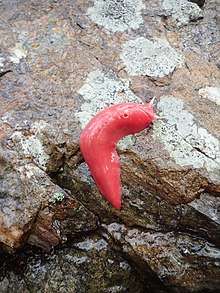Triboniophorus sp. nov. 'Kaputar'
Triboniophorus sp. nov. 'Kaputar', also known as Triboniophorus aff. graeffei or the Mount Kaputar pink slug, is a species of giant air-breathing land slug with a distinctive hot pink hue. These slugs are found on Mount Kaputar in Australia. Taxonomists have confirmed that these slugs are not conspecific with the better-known "red triangle slug", Triboniophorus graeffei.
| Triboniophorus sp. nov. 'Kaputar' | |
|---|---|
 | |
| Scientific classification | |
| Kingdom: | Animalia |
| Phylum: | Mollusca |
| Class: | Gastropoda |
| Subclass: | Heterobranchia |
| Superorder: | Eupulmonata |
| Order: | Stylommatophora |
| Infraorder: | Succineoidei |
| Superfamily: | Athoracophoroidea |
| Family: | Athoracophoridae |
| Subfamily: | Aneitinae |
| Genus: | Triboniophorus |
| Species: | Triboniophorus sp. nov. 'Kaputar' |
| Binomial name | |
| Triboniophorus sp. nov. 'Kaputar' | |
| Synonyms | |
| |
Distribution and habitat
The slugs have only been found at the top of Mount Kaputar, an inland mountain near Narrabri in northern New South Wales within Mount Kaputar National Park, at an altitude around 1,500 metres (4,900 ft) surrounded by snow gum trees.[2] They have been observed to stay within this area,[2] which is estimated to be 100 square kilometres (40 sq mi).[3] Most of the top of the mountain is designated wilderness.[2] Although the mountain is surrounded by dry plains, it receives rainfall and snow, and its temperature is 10 °C (18 °F) cooler than the plains.[2] Thus it forms an isolated ecozone, or sky island; such sky islands are known for unique indigenous fauna and flora.
Around 90% of the total population of the species are thought to have perished in the 2019 Australian wildfires.[4]
Life
The slugs can be seen by the hundreds on cool, wet, misty mornings.[2] During the day, they hide in the plant litter at the base of the trees.[2] At night, they come out and climb the tree to eat algae and mosses growing on the tree trunk.[2] The slugs climb down the tree trunk in the early morning to hide and repeat the cycle.[2]
In the ecosystem, the slugs break down the plant litter into nutrient-rich soil to promote plant growth.[2] They also serve as food for birds and other animals.[2]
Description
The slugs are fluorescent pink in color and up to about 20 centimetres (8 in) in length.[2] In an Australian Broadcasting Corporation interview, New South Wales National Parks and Wildlife Service Ranger Michael Murphy described the color: "as bright pink as you can imagine, that's how pink they are".[2]
Origins
Triboniophorus sp. nov. 'Kaputar' is related but not identical to Triboniophorus graeffei, the red triangle slug. Taxonomists have confirmed the fluorescent pink species' distinction from the red triangle slug.[3] The slug has relatives in New Guinea, New Caledonia, New Zealand, and eastern Africa.[2] These land masses once connected with Australia as the Gondwanaland supercontinent.[2]
A volcanic eruption at Mount Kaputar 17 million years ago created a high-altitude area where these slugs and other invertebrates and plants have lived isolated for millions of years after the surrounding rainforests of eastern Australia vanished due to climate change.[3]
References
- "Triboniophorus sp. nov. 'Kaputar' ". IUCN Red List of Threatened Species. 2014: e.T55242781A55243154. 2014. doi:10.2305/IUCN.UK.2014-3.RLTS.T55242781A55243154.en.
- Coleman, Chris (May 29, 2013). Statewide Afternoons with Chris Coleman. ABC Illawarra (Radio broadcast). Australian Broadcasting Corporation. Archived from the original on June 3, 2013. Retrieved June 3, 2013.
- Cubby, Ben (May 29, 2013). "One will really amaze you, the other just eats his mates". Sydney Morning Herald. Fairfax Media. Archived from the original on June 3, 2013. Retrieved June 3, 2013.
- Kennedy, Else (28 January 2020). "Fluorescent pink slug, unique to Australian mountaintop, survives bushfires". The Guardian. Retrieved 29 January 2020.
Further reading
- Murphy, Michael J.; Shea, Michael (2014). "Survey of the land snail fauna (Gastropoda: Pulmonata) of Mount Kaputar National Park in northern inland New South Wales, Australia, including a description of the listing of Australia's first legally recognised endangered land snail community". Molluscan Research. 35 (1): 51–64. doi:10.1080/13235818.2014.948147.
